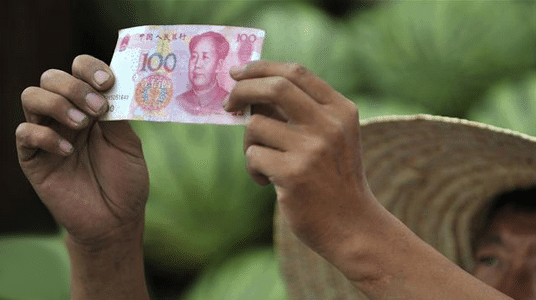Yuan Devaluation: Officials Worry Economy Slumping Faster Than Anticipated
Less than three months before China shocked markets with a surprise devaluation of its currency, a top Chinese exchange-rate official told a closed-door gathering that Beijing had no need for such a dramatic move.
Shockwaves from China’s yuan devaluation will be felt by all kinds of investors, and will likely prompt questions from U.S. politicians. Heard on the Street’s Aaron Back and Abheek Bhattacharya discuss. Photo: Reuters[p][/p]
“Does a deteriorating economy mean there must be a devaluation of the renminbi?” said Yi Gang, the No. 2 official at the People’s Bank of China, using an alternative name for the currency. “Not necessarily.”
According to a transcript reviewed by The Wall Street Journal, Mr. Yi told government officials, academics, businesspeople and investors at the May 22 event in Shanghai that China still had a “very large” trade surplus that should support the currency.
Now, China has done a U-turn.
On Tuesday it pushed the yuan into the largest devaluation in its history, cutting its value against the dollar by 1.9%. The move roiled financial markets and set off worries that other central banks would follow suit. At home, it signals that Beijing is growing increasingly worried about its slowdown in economic growth. Abroad, the move risks further chilling relations between Beijing and Washington ahead of President Xi Jinping’s meeting with President Obama in the U.S. next month.
The currency move came as officials in China’s Commerce Ministry, which oversees exports, and others expressed concern that the economy is slumping faster than China’s leadership had anticipated, according to Chinese officials and government advisers. Chinese officials also worried about this summer’s confidence-shaking stock-market rout. Overall, it suggests that China’s leaders are looking for new ways to rev up growth as other methods look increasingly ineffective, raising the possibility of further and more dramatic efforts to come.
Tuesday’s move shows Beijing is struggling to balance propping the economy with economic reform. The Chinese leadership is shifting toward stabilizing growth rather than accelerating reforms such as opening the country up for freer cross-border capital flows, according to the Chinese officials and advisers to the government. Behind the push is Mr. Xi, who they say over the past two months has repeatedly told local officials that “maintaining economic growth” as the government’s top priority for both near term and the next five years.
“Xi has more than once brought up stabilizing the economy as ‘the center’ of everything,” said one of the officials who is based in eastern China’s Zhejiang province. “Reform will still be carried out, but it’s taking a backseat to stability.”
At the same time, China’s central bank moved in a way that could bolster its efforts to loosen its controls over the currency—a step toward reform. While it didn’t tell the International Monetary Fund or other outside groups about its plans, people close to the central bank say, it made the devaluation using a new mechanism that the PBOC believes will make the yuan more closely aligned with market forces. The central bank also took pains to incorporate some previous IMF suggestions in the new mechanism, the people said.
Spokespeople at the PBOC, China’s Commerce Ministry and China’s cabinet, the State Council, didn’t respond to requests to comment.
The move to devalue the yuan comes as China’s leaders are fighting a host of economic ills that could endanger their goal of achieving a 7% annual growth target for this year, which would be the lowest in a quarter century. They include weak factory output, slumping demand from both home and abroad, and persistent risks of falling prices that could make it harder for Chinese companies to pay off debt. The currency step also followed unprecedented government efforts to prop up China’s faltering stock market, which is jeopardizing Beijing’s plan to restructure China’s heavily indebted state-owned companies.
To shore up growth, China has cut interest rates four times and taken other measures to beef up bank lending since November. Beijing has also freed up local government to issue bonds and the central bank provided financing to commercial banks to purchase those bonds. Since early July, the PBOC has been offering credit to a government agency tasked with propping up falling Chinese shares.
Increasingly they are also turning to their old playbook of ramping up fiscal spending on infrastructure and other government-backed projects—an approach that spurred growth after the 2008 global financial crisis but larded the world’s No. 2 economy with massive debt. The central bank also is pumping billions of dollars of funds into China’s policy banks to finance shanty-town renovations and other big-ticket projects.
China’s cabinet, the State Council, made the decision to devalue the yuan in recent days amid gathering gloom over China’s export sector, according to the officials and advisers. The latest official data shows Chinese exports in July fell a surprising 8.3% from a year earlier. Exports for the first seven months of the year were down 0.8% compared with a year earlier.
At home, China moved to make sure the devaluation wasn’t perceived as a desperate by the government. Ma Jun, chief economist at the central bank, said the devaluation was a “one-off adjustment” and it shouldn’t be seen as the beginning of a weaker currency. Also on Tuesday, the State Internet Information Office issued a directive to state media telling them not to play it up, according to people who received the notice.
Up until now, China’s central bank had been bolstering the yuan’s value by selling large amounts of its dollar holdings to prevent the yuan from sliding against the dollar. It has repeatedly named maintaining the stability of the yuan’s exchange rate as one of its top priorities.
Long-time PBOC Gov. Zhou Xiaochuan for years has push to liberalize the yuan and promote its global use. By implementing the devaluation through a market-based mechanism, the PBOC hopes the new system could convince the IMF to get the yuan included in the fund’s elite basket of reserve currencies, which include the U.S. dollar, the euro, the Japanese yen and the British pound.
The central bank sets the reference rate for the value of the yuan against the U.S. dollar. In daily trading, the yuan is allowed to move 2% above or below that level, which is also known as midpoint, or fixing. But the central bank sometimes ignores the daily market moves, at times setting the fixing so that the yuan is stronger against the dollar a day after the market has indicated it should be weaker.
With Tuesday’s move, the fixing will now be more based on how the yuan closes in the previous trading session, as opposed to being at the complete mercy of the central bank. It’s a change also called for by the IMF, which is expected to make a decision on whether to declare the yuan a reserve currency late this year.
“The PBOC hit two birds with one stone,” saidLarry Hu, China economist at Macquarie Group Ltd, a Sydney-based investment bank. “It caused the yuan to weaken, ending support to exports, and it’s making the exchange rate more market-determined, which could help China win the reserve currency status,” Mr. Hu said.
Still, “the devaluation reflects a change of attitude at the central bank,” said Zhang Ming, a senior economist at the government think tank Chinese Academy of Social Sciences. Mr. Zhang has been publicly making a case for devaluing the yuan to help bolster China’s growth since late May. “The central bank’s preference for maintaining growth is increasing while its desire to win the IMF reserve-currency status is declining.”
How the yuan trades in the next few days would test how far China would let market forces go in terms of determining the yuan’s value.
“If the PBOC was to closely follow the previous day’s closing in setting the daily fixing rate, renminbi depreciation expectations could quickly become entrenched and the yuan could depreciate quite quickly and significantly in the coming days,” said Wang Tao, China economist at UBS AG.
“If so, that would be a sea change in China’s exchange-rate policy as letting the market drive down the yuan can help support growth,” said Ms. Wang, who has cut her forecast for the yuan to about 6.5 per dollar by the end of this year, compared with 6.3 she previously projected.





Leave a Reply
Want to join the discussion?Feel free to contribute!